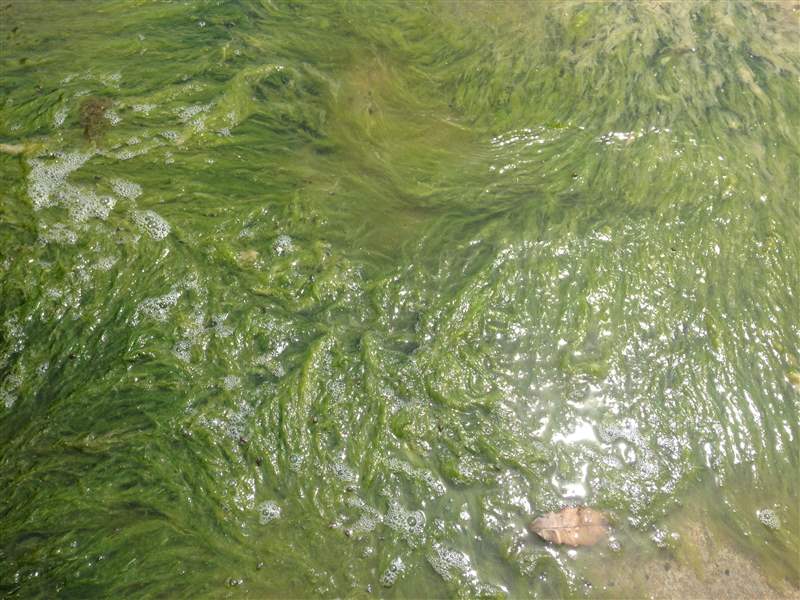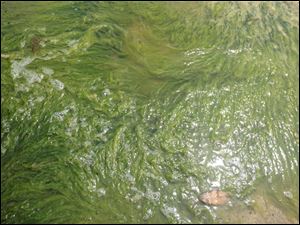
Growing interest in algae issue draws large turnout to forecast meeting
7/12/2018
Last year's algal bloom was severe enough to rate an 8 on a scale of 10, according to local scientists. Experts predict the severity to reach a 6 this year.
THE BLADE/TOM HENRY
Buy This Image
GIBRALTAR ISLAND, Ohio — This summer’s Lake Erie algal bloom is forecast to be six on a scale of 10 for severity — not quite as large as last summer’s bloom, but thick and sizable nonetheless.
“Yes, there will be a significant bloom,” said Rick Stumpf, an oceanographer for the National Oceanic and Atmospheric Administration.

Last year's algal bloom was severe enough to rate an 8 on a scale of 10, according to local scientists. Experts predict the severity to reach a 6 this year.
The forecasts are for what Mr. Stumpf describes as “bloom severity,” a combination of bloom size, intensity, duration, and other factors — not just biomass or “scum” seen floating on top of the water. Researchers hope to someday be able to predict toxicity in advance, as well, but the science for that has not yet been developed.
Last year’s bloom ended up being severe enough to be ranked eight on a scale of 10. Scientists had predicted last July it would be a seven out of 10.
Researchers have said their forecasts become more precise each summer as the relatively new science of predicting blooms gets better developed.
Blooms have chronically reappeared in western Lake Erie annually since 1995 after a 20-year absence, a shift in water quality experts blame on poor agricultural land uses, climate change, invasive species, and other issues.
This year’s prediction was delivered to a capacity crowd of 80 elected officials, scientists, journalists, and advocates for agriculture and environmental issues packed into the conference room of Ohio State University’s Stone Laboratory. It was the seventh annual forecast using a model developed for such predictions.
The water near the island-based research lab is taking on the pea-soup hue that western Lake Erie’s most dominant form of algae, microcystis, is known to form.
University of Toledo algae researcher Tom Bridgeman isn’t sure if the substantial amount of green out there now is the formation of the main bloom. He has seen small pockets of what he calls “mini-blooms” pop up near the Toledo area weeks before the main bloom arrives, then dissipate.
VIDEO: Rick Stumpf, NOAA
The situation has been aggravated by the region’s prolonged heat spell, generating more algae than normal in June. Most of the problem typically arrives in August.
Mr. Stumpf, the federal government scientist who ran the forecast event, said he believes the main bloom has arrived early because of the heat.
Mr. Bridgeman, who came to the event as an observer, agreed that’s plausible. He said he hasn’t seen this much algae in June in his 17 years as a scientist, whether or not it’s the main bloom.
“There's basically a certain amount of fuel out there for the algae now,” Mr. Bridgeman said.
Thursday’s forecast was made one day after Ohio Gov. John Kasich issued an executive order to crack down on bloom-fueling manure releases in western Lake Erie’s most distressed sub-watersheds, a move that critics claim is long overdue but doesn’t go far enough in curbing harmful practices.
VIDEO: Jeff Reutter, retired Ohio Sea Grant and Stone Laboratory director
Laura Johnson, Heidelberg University’s National Center for Water Quality Research director, said this year’s phosphorus runoff is consistent with past years that have had similar amounts of rain. Officials were hoping to see weaker concentrations because of all of the millions of dollars invested in better farming practices by now, especially after the 2014 Toledo water crisis that temporarily made tap water unsafe for that metro system’s 500,000 customers.
Ms. Johnson said she still believes voluntary farm practices intended to reduce phosphorous runoff promoted by the U.S. Department of Agriculture, the Natural Resource Conservation Service, the Ohio Department of Agriculture, the Ohio Farm Bureau Federation, the Ohio Farmers Union, major universities, and others really do work.
But she said it’s obvious now they aren’t being embraced by enough farmers — and that expectations may be too high for rapid results.
“They’re effective, but there’s not enough implementation,” Ms. Johnson said. “I would argue we just haven't had enough time and people need to be patient.”
VIDEO: Laura Johnson, Heidelberg University
Phosphorus runoff measured at the Maumee River sampling station near Waterville and other sites operated by Heidelberg is nearly as high as last year, she said.
But Ms. Johnson said that while she hasn’t had time to study Mr. Kasich’s executive order in depth yet, she believes the general concept of having farmers in distressed sub-watersheds do more to control manure releases makes sense.
New this year was an address by W. Russell Callender, assistant administrator of NOAA’s National Ocean Service, who said toxin-producing harmful algal blooms have grown in importance to Congress.
He said the bloom cost Ohio millions of dollars in lost tourism and recreation value, as well as water-treatment costs.
Contact Tom Henry at thenry@theblade.com, 419-724-6079, or via Twitter @ecowriterohio.